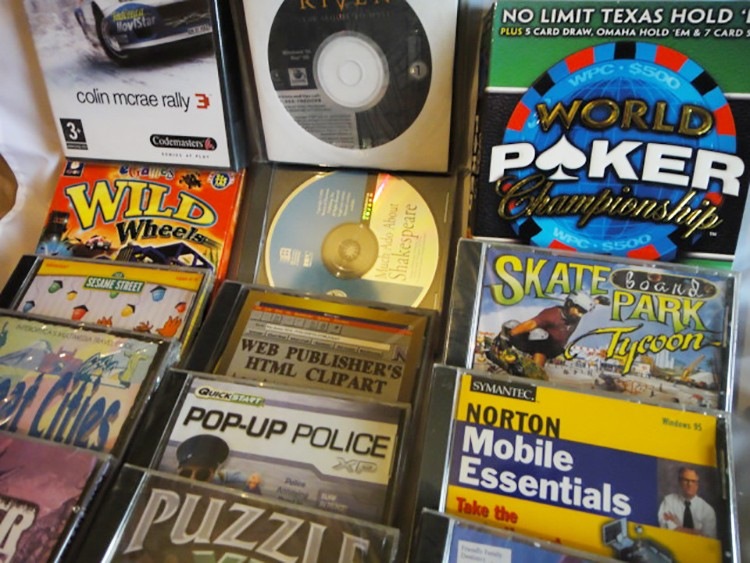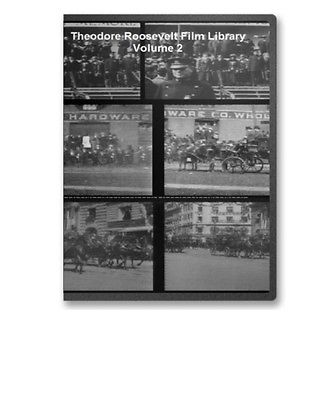The Historical Archive Sample Page Theodore Roosevelt Film Library
Volume 2 (Includes 23 films)
Theodore Roosevelt was the first U.S. president to have his career and life chronicled on a large scale by motion picture companies (even though his predecessors, Grover Cleveland and William McKinley, were the first to be filmed). This presentation features films which record events in Roosevelt's life from the Spanish-American War in 1898 to his death in 1919. Besides containing scenes of Roosevelt, these films include views of world figures, politicians, monarchs, and friends and family members of Roosevelt who influenced his life and the era in which he lived. Commemorative events up to 1921 are also included. All in all, it gives a fascinating look at the life of a president in the early 20th century. The films are silent as they were all shot before sound films were made.
Below you will find sample stil clips from four of the films on this CD
Below you will find a of each film on this CD
President McKinley inauguration, 1901
CREATED/PUBLISHED United States : s.n. , 1901.
SUMMARY The first ca. 49 ft., views of President William McKinley speaking, may be unrelated footage. Views of crowds on Pennsylvania Ave., NW, in front of the old Willard Hotel during the March 4, l90l inaugural festivities. A mounted military unit rides through what is probably the court of honor, the area on Pennsylvania Ave., NW, from Fifteenth to Seventeenth Sts.; the President and his party reviewed the inaugural parade from a stand in this area. McKinley doffs his hat to the crowd as his carriage passes the Willard Hotel. Sen. Marcus A. Hanna of Ohio (1897-1904) sits beside McKinley in the carriage. Several members of the President's special escort, Troop A of the Ohio National Guard, are visible along with aides and guards. The man riding alone in the second carriage may be TR. The last sequence, of McKinley in a carriage in the court of honor, is repeated.
President McKinley's funeral, 1901 1 (in 3 parts)
CREATED/PUBLISHED United States : s.n. , 1901.
SUMMARY Three sequences of the funeral ceremonies held for President William McKinley:
1) McKinley's body lay in state in the Rotunda of the Capitol, Washington, D.C. on Sept. 17, 1901; views of officers on horseback, the Artillery Band (wearing dark headdresses), a squadron of cavalry, a battalion of artillery and coast artillery, Marine Band (wearing white helmets), battalion of Marines, civilians carrying umbrellas (may be the diplomatic corps), other civilians, guard of honor, pallbearers, and the horsedrawn hearse all turning the corner off what may be Pennsylvania Avenue on their way to the Capitol; camera pans the hearse, as a procession of carriages turns the corner.
2) McKinley's body first lay in state for public viewing in Buffalo, N.Y. on Sept. 15-16; views of carriages, the horsedrawn hearse, and marchers stopping in front of the Buffalo City Hall; medium close shots of the casket being unloaded from hearse and carried up stairs of City Hall; crowds of mourners lining up to view the body as group of soldiers enters City Hall; camera pans crowd gathered outside as mourners enter and leave City Hall. Unrelated sequence of Washington ceremonies follows; camera pans from different angles of crowds gathered at the east front of the Capitol.
3) McKinley's body was conveyed to its final resting place at Canton, Ohio on Sept. 18-19; views of mounted military units, marching civilians, carriages, and the horsedrawn hearse turning and entering what is probably Westlawn Cemetery where McKinley is buried; military units marching down a street as gathered crowds watch; final pans of mourners, crowds, and soldiers outside the McKinley home in Canton.
President reviewing school children
CREATED/PUBLISHED United States : American Mutoscope and Biograph Company; 1903.
SUMMARY From the side of a broad avenue, a crowd of people await the arrival of President Theodore Roosevelt. The marching military that precedes his carriage can be seen at a distance of a quarter of a mile away. Four other camera positions along the march include the escort, the dignitaries, and at the conclusion, Roosevelt in his carriage.
President Roosevelt and the Rough Riders
CREATED/PUBLISHED United States : American Mutoscope and Biograph Company, 1898
SUMMARY From the Biograph picture catalogue: 29 feet. This picture shows Col. Roosevelt, accompanied by Lieut. Greenway and other prominent officers of the Rough Riders, galloping up to his headquarters, where he dismounts and walks into his tent. This view was taken in the camp with the Rough Riders, and is an excellent picture of Col. Roosevelt in the environment he loves so well.
President Roosevelt at the Canton station
CREATED/PUBLISHED United States : Thomas A. Edison, Inc., 1901.
SUMMARY The film begins by showing Theodore Roosevelt arriving with other mourners at Canton, Ohio. Mr. Roosevelt is shown leaving the station and getting into his carriage. The remainder of the film was photographed by panning the camera over the large crowd gathered in the area to watch the arrival of celebrities attending the funeral of President McKinley.
Pres. Roosevelt at the dedication ceremonies, St. Louis Exposition
CREATED/PUBLISHED United States : Selig Polyscope Co., 1903.
SUMMARY At the speaker's platform, President Theodore Roosevelt prepares to enter a carriage.
President Roosevelt at the Army-Navy game
CREATED/PUBLISHED United States : American Mutoscope and Biograph Company; 1902.
SUMMARY President Roosevelt, accompanied by Secretary of War Root, Secretary of the Navy Long, and a number of others, crosses the football field during the half-time of the game.
President Roosevelt reviewing the troops at Charleston Exposition
CREATED/PUBLISHED United States : Edison Mfg. Co., 1902.
SUMMARY President Roosevelt is standing on a platform in front of an Auditorium, photographed from across the street. At his left is Mrs. Roosevelt, holding carnations. They review the army, navy, and marine corps foot soldiers at the opening of the Charleston Exposition. Other prominent individiuals shown are Captain F.W. Wagener, Mayor Smyth of Charleston, Governor McSweeney of South Carolina, and Governor Avcock.
Pres. Roosevelt's Fourth of July oration
CREATED/PUBLISHED United States : American Mutoscope and Biograph Company : Kleine Optical Co., 1903.
SUMMARY President Theodore Roosevelt eats and then speaks to a crowd who have gathered to hear him. From another camera position, the crowd bids him farewell as Roosevelt and his party enter a horse-drawn carriage and leave the vicinity.
President Wilson arrives in New York to lead fourth Liberty Loan parade 1918
CREATED/PUBLISHED United States : s.n., 1918 .
SUMMARY Views of fourth Liberty Loan ceremonies in New York City and Washington, Sept. 1918. Inaugurating a national drive for the sale of liberty bonds, President Wilson, his wife Edith, and mother-in-law, Mrs. W. H. Bolling, arrive in New York on Sept. 27, 1918. At Pennsylvania Railroad Station they are greeted by crowds and joined by the President's two daughters, Margaret Wilson and Eleanor McAdoo, as they enter a touring car en route to the Waldorf-Astoria. Views of flag-lined Fifth Avenue on the following day, with flags of the twenty-two Allied nations and banners supporting liberty bonds filling the Avenue. Emile Cartier, Belgian Minister to the United States, speaks at the dedication of the Altar of Liberty, an open-air structure in Madison Square designed by Thomas Hastings in support of the Liberty Loan effort; marching soldiers and band. On the south portico of the U.S. Treasury Building in Washington, D.C., Geraldine Farrar, member of the Metropolitan opera company, ceremonially sells bond to Secretary of the Treasury William Gibbs McAdoo as Leo S. Rowe, Assistant Secretary of the Treasury, watches.
The president's carriage
CREATED/PUBLISHED United States : American Mutoscope and Biograph Company, 1903.
SUMMARY This film shows President Roosevelt in San Francisco, passing in the arrival parade on Market Street on Tuesday, May 12, 1903. The camera view is from the north side of Market Street, just east of Grant Avenue. After leaving the Southern Pacific train station at Third and Townsend streets, the parade proceeded up Third Street and wound through downtown San Francisco before continuing up Market Street to a ceremony at the Native Sons Hall on Mason Street. The film was taken a few minutes after 3:00pm, when the extensive military portion of the parade had already passed. Some of the store signs seen in the film along the south side of Market Street include Townsend's California Glace Fruits, Swan the Painter, Charles Lyons (merchant tailor), Morley Billiards, and Spreckles Market.
The Prince of Wales visits TR's grave
CREATED/PUBLISHED United States : s.n. , 1919.
SUMMARY In the summer of 1919, Edward, the Prince of Wales, later King Edward VIII, embarked on a tour of the Dominions. After touring Canada for several months, the Prince decided to spend several days in the United States. His visit was the first visit of a Prince of Wales to the United States since that of his grandfather, Edward VII, fifty years earlier. On his last day in New York, Nov. 21, 1919, the Prince made a semiprivate journey to Oyster Bay. Film shows the Prince placing a laurel wreath on TR's grave in Youngs Memorial Cemetery; the Prince, Theodore Roosevelt Jr., wearing a mourning band, a man who is probably Joseph M. Nye, Chief of Special Agents, Dept. of State, and a group of men return down the path from the gravesite. Behind the Prince, the man wearing dark glasses is probably Viscount Grey, British Ambassador to the United States. A man wearing an ascot and walking in the rear of the group may be Rodman Wanamaker, Chairman of the Mayor's Committee on Reception to Distinguished Guests. The Prince tips his hat to people gathered alongside the path.
Clemenceau and Foch, 1917-1919
CREATED/PUBLISHED United States : s.n., 1918?
SUMMARY Film appears to have been photographed in France during WWI. Medium close shot of Quentin Roosevelt with a small building in background; brief shot of French and American officers, including Lieutenant Edward V. Rickenbacker at immediate right, talking; view of a troop train moving through a European town as people line the tracks waving to soldiers. Final sequence is medium close panning shots, from left to right, of: John J. Pershing, commander in chief of American forces; Andr Tardieu, French diplomat; Premier Georges Clemenceau of France; Marshal Ferdinand Foch, commander in chief of French forces; an unidentified French officer; General Maxime Weygand, staff officer to Foch; and Major General James W. McAndrews, general chief of staff of American forces, posing as they leave a building.
RMA flag service on the steps of New York Public Library, 1919
CREATED/PUBLISHED Kinogram Pub. Corp. 1919
SUMMARY On October 27, 1919 the Roosevelt memorial flag, which has been carried across New York State in TR's honor, is brought to rest at his grave in Youngs Memorial Cemetery, Oyster Bay, N.Y. Views of Samuel Abbott, originator of the memorial flag idea, placing the flag on TR's grave. Sequence of two young girls and a boy placing flower bouquet and flag through fence surrounding TR's grave, event may not be part of flag ceremonies. Final scenes of flag ceremony sponsored by Roosevelt Memorial Association on the steps of New York Public Library, Oct. 25; long shots of notables standing on platform, possible identifications from right to left are: Henry Cabot Lodge, honorary vice-president of RMA; the man next to Lodge is probably Henry J. Allen, Governor of Kansas; William Boyce Thompson, president of RMA, is holding the flag with the help of a man who appears to be Henry D. Lindsley, chairman of the event; William Loeb Jr., vice-president of RMA, is visible in back of Thompson; next to Loeb is probably William Gibbs McAdoo; and the man to the far left with hands to his side may be Elihu Root, an RMA trustee. Sequence of Boy Scouts and members of the Naval Reserve hoisting flag up flagpole as an unidentified man leads the crowd in singing.
Roosevelt scenes 1917-1918
CREATED/PUBLISHED United States : s.n., 1917?
SUMMARY Views of TR at various public functions in support of the war effort: 1) TR stands with Brigadier General Michael J. Lenihan, fellow-officer in the Spanish-American War, and speaks to camera during an informal visit to Camp Mills, near Garden City, N.Y., on Sept. 2, 1917; 2) on the lawn of Sagamore Hill on Aug. 22, 1917, TR and members of the Belgian mission pose for camera; identified in group are Capt. Thomas C. Cook, American Army officer; Hector Carlier, a secretary of the mission; Major Leon Osterrieth, Belgian Army officer; George T. Wilson and Frederic Coudert, prominent New Yorkers; Baron Ludovic Moncheur, former Ambassador to the United States and head of the mission; General Mathieu Leclercq, Commander of the Belgian Cavalry; Jean D. Mertens, a secretary of the mission; T. P. O'Connor, Irish political leader and writer; and Count Louis d'Ursel, Belgian Army officer and diplomat; 3) at Forest Hills, N.Y., on July 4, 1917, TR reviews and marches with the Forest Hills Rifle Club; 4) on Sept. 28, 1917, TR speaks at a large pro-war parade in St. Paul, Minn., with Minnesota Governor Joseph A. A. Burnquist (1915-1921) standing behind him on platform; 5) supporting the Liberty Loan effort in Billings, Mont., TR parades through downtown Billings street, preceded by cowboys on horseback; 6) at Camp Grant, Rockford, Ill., TR and Thomas H. Barry, Commander of the camp, address troops on Sept. 26, 1917; 7) TR speaks to crowds at the launching of the U.S.S. Newburgh in Newburgh, N.Y., Sept. 2, 1918; 8) from the porch at Sagamore TR addresses volunte
 Login
Login
 Login
Login












